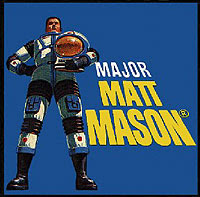 |
| 1968.02.29 Hastings NY News Page 5 |
 |
| 1968.02.29 Hastings NY News Page 5 "Challenge of Science Takes Form For Young Ardsley Fifth Graders" Image |
Image Caption: GI Joe or Major Matt Mason? No...it's Ardsley science teacher Robert Eusner, shown with two of his space age models and a group of fifth grade students.
 |
| 1968.02.29 Hastings NY News Page 5 "Challenge of Science Takes Form For Young Ardsley Fifth Graders" by Joan Intrator Article |
Challenge of Science Takes Form For Young Ardsley Fifth Graders
By JOAN INTRATOR
"Can there be thunderclaps in outer space?'. "What does a rocket push against in space in order to propell (sic) itself?"..."Can a rocket land on a star?
Who asks these questions? According to a fifth grade teacher at the Ashford Ave. Elementary School in Ardsley, the questions are asked by kindergarten children, and most parents couldn't even begin to offer them sensible answers.
Curiosity about space age phenomena prompts an early interest in the environment outside earth, explains Robert Eusner, general science teacher. He thinks the youngsters are capable of understanding accurate answers.
To this end, after completing the regular unit of his fifth grade science course - an introduction to biology, geography, physics and the like - Mr. Eusner throws in an extra unit of his own which he calls The Challenges of Space.
One of the demonstration aids for this unit is currently on display in his room an exhibit of satellite models and posters procured by him from various NASA space centers all over the United States.
Fourteen beautifully-constructed working models of various satellites have been shipped to Ardsley at Mr. Eusner's request through a personal contact in the space agency; the models are duplicates of various space-craft (sic) the US has launched for interplanetary exploration, weather research, communications and unmanned flights.
On view recently to parents and administrators were not only the one-eighth scale models of Telestar (sic), Mariner IV, Surveyor and Syncom but replicas of the Gemini and Mercury capsules, together with authentically-clad dummies of their navigators. The capsules, one-third actual size, produced a wave of bug-eyed camera fiends at the school last month, he said.
NASA also sent films of the astronauts space-walk, showing the earth's geography in strange - and actual - perspective. There is even a poster-reproduction of the last pictures of earth relayed back by Ranger one-quarter of a second before its moon-impact,
Mr. Eusner opened up a $10,000 model of a communications satellite, one of two such prototypes in existence. Apparently no other school has been permitted to borrow such an amazing exhibit of models and teaching-aids. According to Mr. Eusner, it took a year and a half to arrange for the models to be loaned and shipped here.
A lively young man in his twenties, Mr. Eusner told Greenburgh Publications that his aim was "to introduce scientific areas, ideas and terms on the most sophisticated level possible" which fifth-graders can absorb.
"I really hope to whet their appetites for more particularized study later on," he said. "I try to teach my students the scientific method and approach to problems." The most difficult thing, Mr. Eusner admits, is "having students learn how to plan and organize their time. If some of the kids take this with them, then I'm satisfied..."
He acknowledges that his standards and expectations "are very high," and readily admits that be demands "a lot of work from the kids taking my course."
His goals, however, are tempered with a sense of "compassion" for errors and failure "as long as the error is made only once," he qualifies with a grin,
He wants his students to begin to look at their world "realistically," and believes becoming acquainted with "the scientific method in general encourages this attitude.
A sample lab sheet used by his fifth graders for experiments indicates an approach usually seen only on the high school level: a statement of the problem, hypothesis, materials, used, diagram, procedure, observations, conclusion.
Teaching in Ardsley for five years, Mr. Eusner has a delightfully oddball reputation as a teacher with a sense of the dramatic- he has, for instance, been known to make his classroom appearance in a suit of armor, a scuba diving outfit, in a colonial costume complete with powdered wig.
Very much involved with his students, he has organized a Science Club, where students grow crystals, atomic seeds and bacteria cultures and dissect brains and lungs.
Not much of an eater, he utilizes his lunch-hour for chats with students who "are always dropping in for 'scientific discussions.'" Each year, he and his wife, also a teacher, take to dinner one boy and one girl who, according to classroom consensus, "have shown the most improvement."
Mr. Eusner also finds time for lecture-demonstrations at several local schools and colleges; on a consultant basis, he previews teaching films in the areas of science, social studies and industrial arts.
Bob Eusner thinks the responses of most of his students are "great" but would like to see the elementary science curriculum grouped homogeneously by ability-level in the way that the reading and math program is grouped.
Perhaps he will be the one to do this ... in his spare time!







No comments:
Post a Comment